Best Hip Pain Treatment in Nagpur

Hip Pain Treatment: Causes, Symptoms, and Effective Solutions
Hip pain is a prevalent issue that impacts individuals across various age groups, ranging from young sports enthusiasts to older adults. The hip joint, recognized as one of the largest weight-bearing joints in the human body, is vital for movement and everyday functions. It is important to comprehend the underlying causes, associated symptoms, and available treatment alternatives for hip pain to effectively manage discomfort and avert potential long-term complications.
Causes of Hip Pain Hip pain can stem from various causes, ranging from acute injuries to chronic conditions
Some of the most common causes include:
- Arthritis, including osteoarthritis and rheumatoid arthritis, along with other types, frequently contributes to hip pain, particularly among the elderly population.
- Injuries such as fractures, dislocations, and sprains, which may occur due to falls, accidents, or sports activities, can also result in considerable hip discomfort.
- Tendinitis, characterized by the inflammation of the tendons surrounding the hip joint, often arises from repetitive motions or excessive use.
- Bursitis, the inflammation of the bursae—small fluid-filled sacs around the hip joint—can lead to localized pain.
- A hip labral tear, which involves damage to the cartilage encircling the hip socket, may cause both pain and restricted movement.
- Muscle strains resulting from overstretching or tearing of the muscles and ligaments in the hip area can contribute to discomfort.
- Conditions such as sciatica or nerve compression may lead to pinched nerves, resulting in hip pain.
Symptoms of Hip Pain The symptoms of hip pain can vary based on the underlying cause.
Common symptoms include:
- Continuous dull or acute discomfort in the hip joint.
- Limited mobility in the hip region.
- Rigidity in the hip area, particularly following extended periods of sitting or standing.
- Inflammation or sensitivity surrounding the hip joint.
- Challenges in walking, standing, or ascending stairs.
- Discomfort that extends to the thigh, groin, or buttocks.
Hip Pain Treatment Options The treatment for hip pain depends on its cause and severity.
Common treatment options include:
- Rest and Activity Modification: It is essential to refrain from activities that exacerbate the pain while allowing the joint adequate time to recover.
- Physical Therapy: Engaging in exercises designed to enhance the strength of the hip muscles, increase flexibility, and restore overall mobility.
- Medications: Utilizing over-the-counter analgesics, anti-inflammatory medications, and corticosteroid injections as needed.
- Ice and Heat Therapy: Implementing a regimen of alternating ice packs and heating pads to alleviate inflammation and relieve discomfort.
- Assistive Devices: Employing crutches, canes, or walkers to minimize stress on the hip joint.
- Weight Management: Sustaining a healthy body weight to lessen the burden on the hip.
- Surgical Intervention: In cases of severe impairment, surgical options such as hip replacement or hip arthroscopy may be warranted.
Preventing Hip Pain Prevention is key to avoiding hip pain.
Some preventive measures include:
- Establishing a consistent exercise regimen that emphasizes strength and flexibility is essential.
- It is important to practice correct posture while sitting, standing, and walking. One should also refrain from placing undue stress on the hip joint.
- Utilizing supportive footwear is advisable.
- Incorporating low-impact activities like swimming or cycling can also be advantageous.